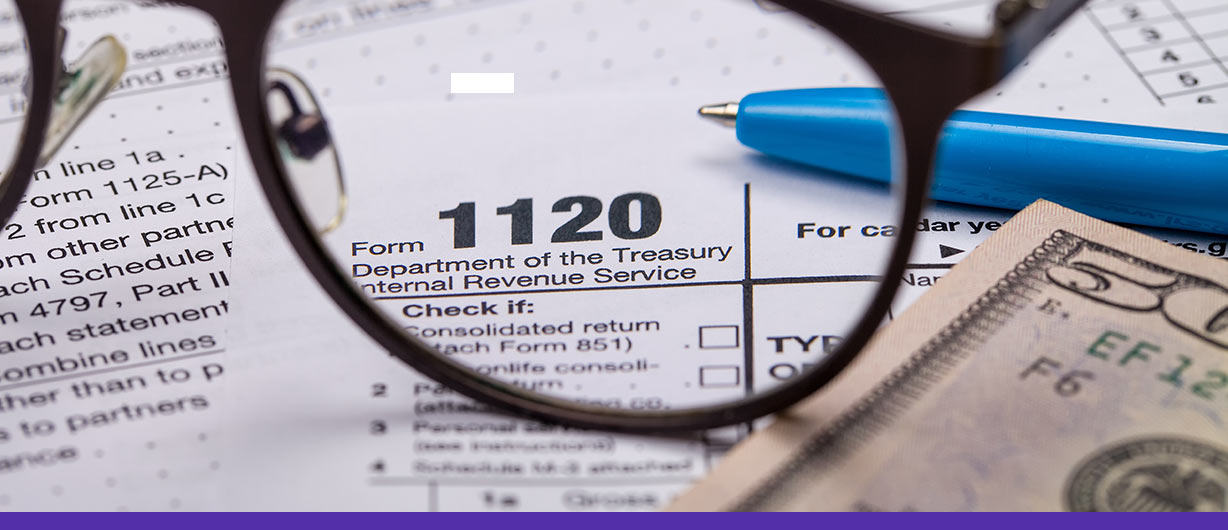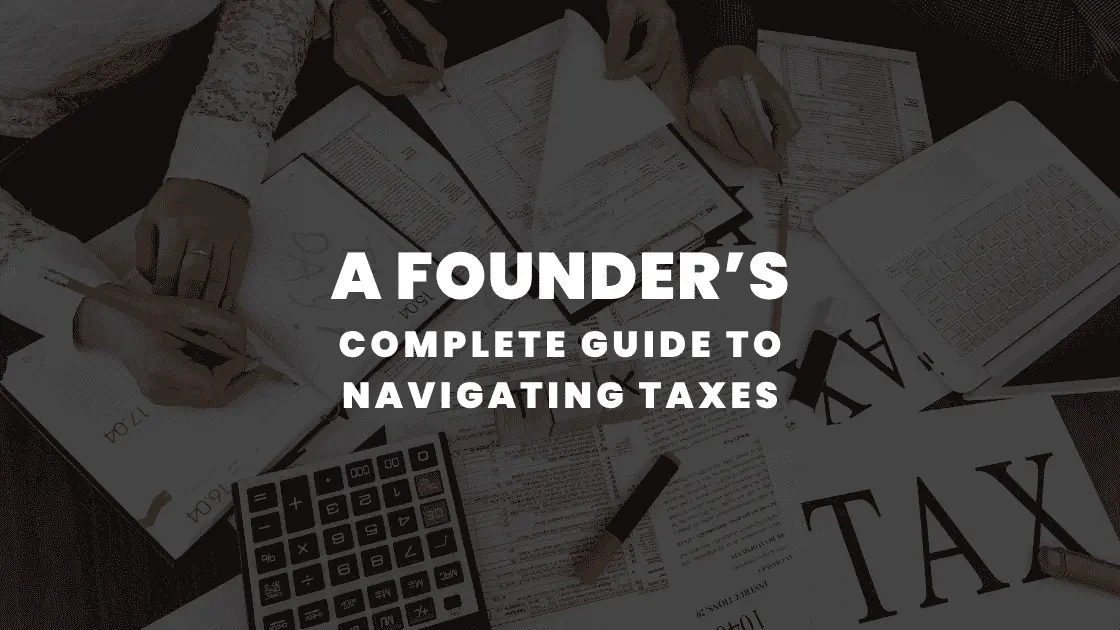October 20 2023 | By Farwah Jafri | 6 minutes Read

During the tax filing season, you must consider various expenses related to your car and business meals. A recent survey by Capital One found that 56% of small business owners worry the most about taxes. Filing your taxes can be complex, but whether you do it yourself with IRS forms, use tax software, or hire a tax professional, understanding the necessary forms for your business can make tax season less stressful.
Form 1120 is a special tax form used for corporations in the United States, like a report card for a company’s money matters. It calculates the tax a corporation needs based on its income, profits, losses, and expenses, as well as special tax benefits. Big corporations (C corporations) and some Limited Liability Companies (LLCs) use this form to settle their tax bill. An LLC with more than one owner is usually treated like a partnership for tax purposes.
Almost all-American corporations, unless they have a special reason not to, must use Form 1120 to file their taxes. It’s a must-do unless you’re a special corporation with a different tax form.
Ready to learn how to fill out Form 1120 for your corporation’s taxes? Let’s walk through the process step by step.
Before completing the six-page Form 1120, you must gather important details about your corporation. Make sure you have the following information ready:
– Your Employer Identification Number (EIN)
– Date of incorporation
– Total assets
– Gross receipts and sales
– Cost of goods sold (COGS)
– Tax deductions
– Tax credits
– Capital gains
– Dividend, interest, and royalties earned
– Liabilities
– Shareholder equity
You can usually find this information on your financial statements and records. If you need help locating your EIN, check your previous tax returns.
To begin filling out Form 1120, you’ll need to enter some fundamental details about your corporation, including:
– Corporation name
– Address
– Employer Identification Number (EIN)
– Date of incorporation
– Total assets
You must make sure to inform the IRS if this is your first or final tax return or if you’ve had any changes in your corporation’s name or address.
Form 1120 has several sections, but we’ll focus on the first page. Here’s what you need to do:
Income
– Line 1a: Report your corporation’s gross receipts or sales
– Line 1b: Record returns and allowances
– Line 1c: Calculate the balance between gross receipts or sales, returns, and allowances Cost of Goods Sold
– Line 2: Report your cost of goods sold. Attach Form 1125-A for more details
Gross Profit
– Line 3: Determine your corporation’s gross profit (the difference between revenue and cost of goods sold)
Dividends and Inclusions
– Line 4: Following Schedule C on page 2, report dividends and inclusions Interest and Rents
– Line 5: Include taxable interest
– Line 6: Report gross rents
– Line 7: Enter gross royalties
Capital Gains and Other Income
– Line 8: Record your capital gain net income (attach Schedule D)
– Line 9: Report net gain or loss (from Form 4797)
– Line 10: Include other income not reported on lines 1 through 9 (attach a statement detailing the type and amount of income)
– Line 11: Record the sum of figures in lines 3 through 10 for your total income
Business Deductions
The next section is where you record deductions. There are various limitations, so consult IRS Form 1120 Instructions for more information:
– Line 12: Record the compensation of officers
– Line 13: Report total salaries and wages (minus employment credits)
– Line 14: Include deductible repairs and maintenance
– Line 15: Enter total bad debts
– Line 16: Record vehicle rent or lease expenses
– Line 17: Include taxes paid or accrued, excluding specific taxes
– Line 18: Report interest expenses
– Line 19: Record charitable contributions
– Line 20: Add depreciation and expensed property (attach Form 4562)
– Line 21: Record depletion if applicable
– Line 22: Report deductible advertising expenses
– Line 23: Enter deductions for contributions to employee benefit plans (additional returns may be required)
– Line 24: Note contributions to non-incidental employee benefit programs
– Line 25: Reserved for future use
– Line 26: Include other deductions not mentioned elsewhere (attach a statement)
– Line 27: RecorRecorRecord the sum of figures in the sum of figures in the sum of figures in lines 12 through 26 for total deductions
Tax, Refundable Credits, and Payments
This section is where you calculate your total taxes, credits, and your balance with the IRS:
– Line 30: Determine your corporation’s total taxable income
– Line 31: Report your total tax (from Schedule J)
– Line 32: Reserved for future use
– Line 33: Include your total payments and credits (from Schedule J)
– Line 34: Enter your estimated tax penalty (attach Form 2220 forfor specific cases)
– Line 35: Calculate the balance due, if any
– Line 36: Report any overpayment
– Line 37: Specify the amount to be refunded or applied to next year’s estimated tax if you overpaid
Signature
The final step is to sign the form. Only specific individuals are authorized to sign Form 1120, such as the President, Vice President, Treasurer, Assistant Treasurer, Chief Accounting Officer, or other corporate officers.
Form 1120-S serves as the tax report for S corporations. It’s like their financial report card to the IRS. In this form, S corporations share details about how much money they made or lost, any special tax benefits they got, deductions they claimed, and other important financial information. They can submit this form either electronically or through regular mail.
Along with Form 1120-S, they must include Schedule K-1, which tells who the individual shareholders are and how much money they earned, lost, received in tax benefits, and claimed in deductions.
Form 1120-S is for S corporations only. This form can only be used if the IRS has accepted the company’s decision to become an S corporation, and the company must have fewer than 100 shareholders. Any corporation member or a tax expert can prepare this form, which can be submitted electronically or by regular mail.
Form 1120-S is the yearly tax report for S corporations. It needs to reach the IRS by the 15th of the third month after the end of the corporation’s tax year.
For instance, if a company’s tax year runs from January 1 to December 31, their tax return must be in by March 15. But if the company’s tax year is from July 1 to June 30, they have until September 15 to complete and send Form 1120-S.
Every entity, be it an individual or a business, must inform the IRS about its yearly taxes. For S corporations, the special form is Form 1120-S. These businesses have fewer than 100 shareholders, and they share their profits and losses among these shareholders. The forms can be sent electronically or by regular mail to the IRS, but they must always include Schedule K-1. Remember, it must all be sent to the IRS by the 15th of the third month after the corporation’s tax year ends.
Also Read: A Guide To IRS Form 720
Subscribe for business tips, tax updates, financial fundamentals and more.
MORE BLOGS

Starting a business is exciting, right? There’s innovation, there’s growth potential, and the thrill of building something from scratch. But amid all the planning, entrepreneurs often […]
Learn More →
Starting a business is quite thrilling, until tax season arrives. For founders, understanding the nitty gritty of startup taxation can make a difference between financial efficiency […]
Learn More →
Tax season can be overwhelming, especially when you’re staring at multiple forms with numbers instead of names. Two of the most common, and often misunderstood, are […]
Learn More →